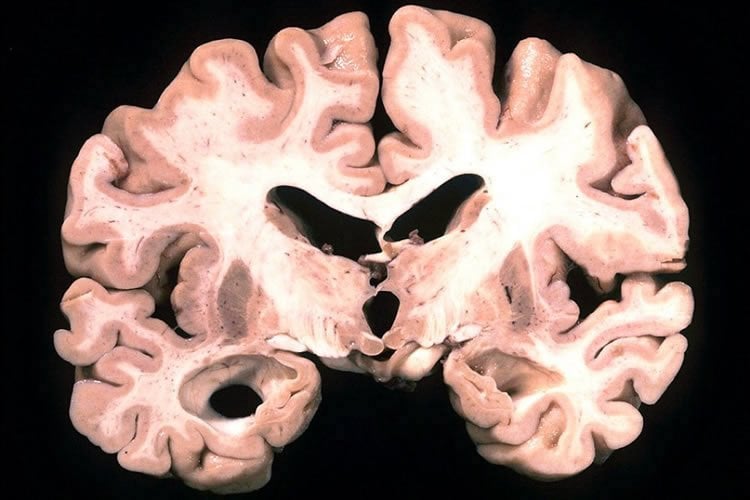People with Alzheimer’s disease have fat deposits in the brain. For the first time since the disease was described 109 years ago, researchers affiliated with the University of Montreal Hospital Research Centre (CRCHUM) have discovered accumulations of fat droplets in the brain of patients who died from the disease and have identified the nature of the fat.
This breakthrough, published today in the journal Cell Stem Cell, opens up a new avenue in the search for a medication to cure or slow the progression of Alzheimer’s disease. “We found fatty acid deposits in the brain of patients who died from the disease and in mice that were genetically modified to develop Alzheimer’s disease. Our experiments suggest that these abnormal fat deposits could be a trigger for the disease”, said Karl Fernandes, a researcher at the CRCHUM and a professor at University of Montreal.
Over 47.5 million people worldwide have Alzheimer’s disease or some other type of dementia, according to the World Health Organization. Despite decades of research, the only medications currently available treat the symptoms alone.
This study highlights what might prove to be a missing link in the field. Researchers initially tried to understand why the brain’s stem cells, which normally help repair brain damage, are unresponsive in Alzheimer’s disease. Doctoral student Laura Hamilton was astonished to find fat droplets near the stem cells, on the inner surface of the brain in mice predisposed to develop the disease. “We realized that Dr. Alois Alzheimer himself had noted the presence of lipid accumulations in patients’ brains after their death when he first described the disease in 1906. But this observation was dismissed and largely forgotten due to the complexity of lipid biochemistry”, said Laura Hamilton.
The researchers examined the brains of nine patients who died from Alzheimer’s disease and found significantly more fat droplets compared with five healthy brains. A team of chemists from University of Montreal led by Pierre Chaurand then used an advanced mass spectrometry technique to identify these fat deposits as triglycerides enriched with specific fatty acids, which can also be found in animal fats and vegetable oils.
“We discovered that these fatty acids are produced by the brain, that they build up slowly with normal aging, but that the process is accelerated significantly in the presence of genes that predispose to Alzheimer’s disease”, explained Karl Fernandes. In mice predisposed to the disease, we showed that these fatty acids accumulate very early on, at two months of age, which corresponds to the early twenties in humans. Therefore, we think that the build-up of fatty acids is not a consequence but rather a cause or accelerator of the disease.”

Fortunately, there are pharmacological inhibitors of the enzyme that produces these fatty acids. These molecules, which are currently being tested for metabolic diseases such as obesity, could be effective in treating Alzheimer’s disease. “We succeeded in preventing these fatty acids from building up in the brains of mice predisposed to the disease. The impact of this treatment on all the aspects of the disease is not yet known, but it significantly increased stem cell activity,” explained Karl Fernandes. “This is very promising because stem cells play an important role in learning, memory and regeneration.”
This discovery lends support to the argument that Alzheimer’s disease is a metabolic brain disease, rather like obesity or diabetes are peripheral metabolic diseases. Karl Fernandes’ team is continuing its experiments to verify whether this new approach can prevent or delay the problems with memory, learning and depression associated with the disease.
Funding: The research was funded by Canadian Institutes of Health Research, Canada Research Chairs, Alzheimer Society of Canada, Fonds de recherche du Québec – Santé.
Source: William Raillant-Clark – University of Montreal
Image Credit: The image is in the public domain
Original Research: Abstract for “Aberrant Lipid Metabolism in the Forebrain Niche Suppresses Adult Neural Stem Cell Proliferation in an Animal Model of Alzheimer’s Disease” by Laura K. Hamilton, Martin Dufresne, Sandra E. Joppé, Sarah Petryszyn, Anne Aumont, Frédéric Calon, Fanie Barnabé-Heider, Alexandra Furtos, Martin Parent, Pierre Chaurand, Karl J.L. Fernandes in Cell Stem Cell. Published online August 27 2015 doi:10.1016/j.stem.2015.08.001
Abstract
Aberrant Lipid Metabolism in the Forebrain Niche Suppresses Adult Neural Stem Cell Proliferation in an Animal Model of Alzheimer’s Disease
Highlights
•Early NSC impairment in 3xTg-AD mice correlates with SVZ niche lipid accumulations
•Similar lipid accumulations are found in the SVZ in postmortem human AD brains
•Accumulating SVZ lipids are locally generated, oleic acid-enriched triglycerides
•Inhibiting oleic acid signaling or synthesis rescues NSC defects in 3xTg-AD mice
Summary
Lipid metabolism is fundamental for brain development and function, but its roles in normal and pathological neural stem cell (NSC) regulation remain largely unexplored. Here, we uncover a fatty acid-mediated mechanism suppressing endogenous NSC activity in Alzheimer’s disease (AD). We found that postmortem AD brains and triple-transgenic Alzheimer’s disease (3xTg-AD) mice accumulate neutral lipids within ependymal cells, the main support cell of the forebrain NSC niche. Mass spectrometry and microarray analyses identified these lipids as oleic acid-enriched triglycerides that originate from niche-derived rather than peripheral lipid metabolism defects. In wild-type mice, locally increasing oleic acid was sufficient to recapitulate the AD-associated ependymal triglyceride phenotype and inhibit NSC proliferation. Moreover, inhibiting the rate-limiting enzyme of oleic acid synthesis rescued proliferative defects in both adult neurogenic niches of 3xTg-AD mice. These studies support a pathogenic mechanism whereby AD-induced perturbation of niche fatty acid metabolism suppresses the homeostatic and regenerative functions of NSCs.
“Aberrant Lipid Metabolism in the Forebrain Niche Suppresses Adult Neural Stem Cell Proliferation in an Animal Model of Alzheimer’s Disease” by Laura K. Hamilton, Martin Dufresne, Sandra E. Joppé, Sarah Petryszyn, Anne Aumont, Frédéric Calon, Fanie Barnabé-Heider, Alexandra Furtos, Martin Parent, Pierre Chaurand, Karl J.L. Fernandes in Cell Stem Cell. Published online August 27 2015 doi:10.1016/j.stem.2015.08.001






